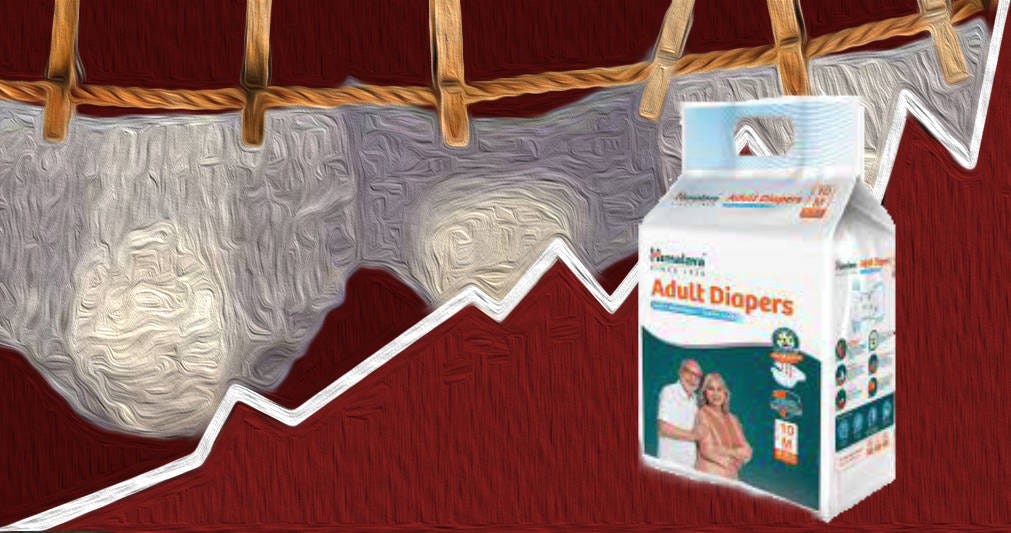The Great Pause Week 91: The Diaper Index
In Japan they have a new indicator for the population demographic — adult diapers.
“A human being should be able to change a diaper, plan an invasion, butcher a hog, conn a ship, design a building, write a sonnet, balance accounts, build a wall, set a bone, comfort the dying, take orders, give orders, cooperate, act alone, solve equations, analyze a new problem, pitch manure, program a computer, cook a tasty meal, fight efficiently, die gallantly. Specialization is for insects.”
― Robert A. Heinlein
Scientists and engineers like to use charts and indicators to aid in the visual representation of complex data. We all think more clearly when we can visualize something. In Japan they have a new graphical indicator for the population demographic — diapers.
Unfortunately these are not the kind that typically wrap the bare bottoms of babies. These are the kind keeping geriatric butts sanitary. In rapidly aging Japan, more diapers are used by older, incontinent people than by babies. Were it not for immigration, mainly from Asia and Latin America, the same might be true in the United States.
In Japan population change is becoming a waste problem more than an immigration issue. Waste from adult diapers is growing by tens of thousands of tons per year and most municipalities just incinerate the contaminated plastics. A few draw the heat off for buildings and hot water systems. In Houki, a town of just over 10,500 people in Tottori Prefecture, adult diapers represent about a tenth of the town’s trash. Houki makes its dirty diapers into fuel to reduce natural gas heating costs of the municipal-owned swimming pool.
The amount of adult diapers entering the waste stream in Japan has increased by nearly 13 percent, to almost 1.5 million tons annually, in the last five years, according to data from the environment ministry. It is projected to grow a further 23 percent by 2030, when those 65 and older will represent close to a third of the population.
— The New York Times, December 3, 2021
The larger issue that diapers wrap is human scale in a finite space. As the Japanese population both ages and shrinks at the same time, incontinence products for seniors grow, just as do the needs for senior health care, retirement homes, and morticians.
At the recycling plant, he and his co-worker, dressed in Tyvek body suits, rubber boots and helmets, dump the diapers into a vat the size of a small trailer. They are sterilized and fermented for 24 hours in 350-degree heat, which cuts their volume to a third of their soiled weight. The process converts the diapers into a fluff that is processed through another machine and turned into two-inch-long gray pellets.
The operations slightly evoke the factory scenes from “Soylent Green,” the 1973 dystopian thriller in which nutrition wafers are made from human remains. Despite ceramic and charcoal filters designed to remove foul odors, the machinery emitted a faint yeasty, toasted smell as pellets rained down from a bright orange chute into a large plastic box.
One smart company is seizing the opportunity to bring diapers into the new carbon economy that will reverse climate change. Iwamoto Inc. developed its line of Super Stone Clean. The evolving generations of its patented Z series pyrolyzers advertise high-volume on-site diaper processing, municipal solid waste reduction, energy and secondary product creation. By pyrolyzing (carbonizing in the absence of oxygen) rather than incinerating (burning or oxidizing), Iwamoto makes biochar rather than ash. Although it likely contains plastic residues unsuited for agricultural uses, this kind of biochar can be applied in applications like biocrete or wallboard for buildings. It can also be made into plastics. Unicharm, one of Japan’s largest diaper manufacturers, has built a pilot plant in Kagoshima, in southern Japan, where it is recycling diapers back into more diapers.
… the machinery emitted a faint yeasty, toasted smell as pellets rained down from a bright orange chute into a large plastic box…
In 2021, after a summer of small-scale testing, the enterprising Norwegian company Snøhetta teamed up with experienced contractors, researchers, producers and suppliers within the concrete and biochar industries to erect Norway’s first carbon negative precast concrete wall. A Snøhetta press release said:
The construction industry is an industry with significant greenhouse gas emissions, and concrete alone makes up about 8% of CO2 emissions globally. However, it is challenging to imagine that we will build less in the years to come, and even more so to imagine that we will find a material as versatile as concrete. Therefore, we must find more environmentally friendly solutions that allow us to build for the future without contributing to making it less liveable for future generations, and the construction industry must be a part of this green change. Hence concrete seemed like an obvious place to start, and wood waste from the construction industry a sensible resource to utilize. This is the idea that grew to become our Biocrete project.
Now imagine the cities of the future cast from your grandfather’s soiled diapers and energized by your own toilet wastes. To paraphrase Heinlein, “a human being should be able to change a diaper and plan a building at the same time.”
The COVID-19 pandemic has destroyed lives, livelihoods, and economies. But it has not slowed down climate change, which presents an existential threat to all life, humans included. The warnings could not be stronger: temperatures and fires are breaking records, greenhouse gas levels keep climbing, sea level is rising, and natural disasters are upsizing.
As the world confronts the pandemic and emerges into recovery, there is growing recognition that the recovery must be a pathway to a new carbon economy, one that goes beyond zero emissions and runs the industrial carbon cycle backwards — taking CO2 from the atmosphere and ocean, turning it into coal and oil, and burying it in the ground. The triple bottom line of this new economy is antifragility, regeneration, and resilience.
Help me get my blog posted every week. All Patreon donations and Blogger subscriptions are needed and welcomed. You are how we make this happen. Your contributions are being made to Global Village Institute, a tax-deductible 501(c)(3) charity I have been involved with since its inception in 1974. PowerUp! donors on Patreon get an autographed book off each first press run. Please help if you can.
#RestorationGeneration #Regenerosity
“There are the good tipping points, the tipping points in public consciousness when it comes to addressing this crisis, and I think we are very close to that.”
— Climate Scientist Michael Mann, January 13, 2021.
Want to help make a difference while you shop in the Amazon app, at no extra cost to you? Simply follow the instructions below to select “Global Village Institute” as your charity and activate AmazonSmile in the app. They’ll donate a portion of your eligible purchases to us.
How it works:
1. Open the Amazon app on your phone
2. Select the main menu (=) & tap on “AmazonSmile” within Programs & Features
3. Select “Global Village Institute” as your charity
4. Follow the on-screen instructions to activate AmazonSmile in the mobile app






